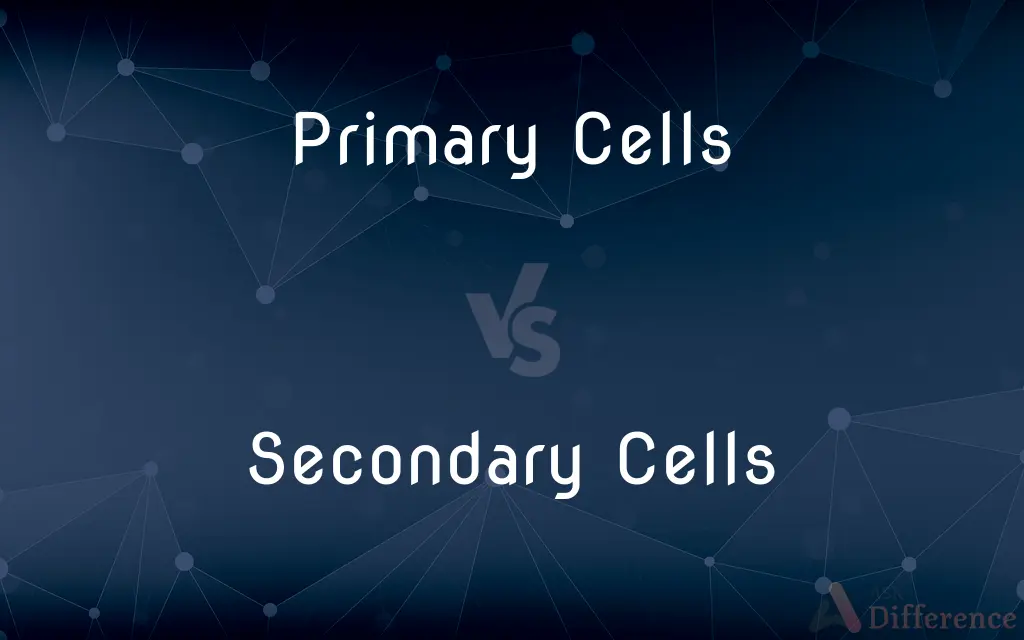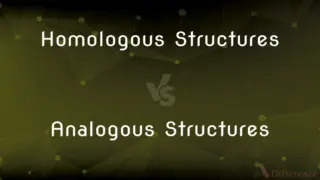Primary Cells vs. Secondary Cells — What's the Difference?
Edited by Tayyaba Rehman — By Fiza Rafique — Published on December 19, 2023
Primary Cells are non-rechargeable batteries used once and discarded; Secondary Cells are rechargeable batteries used multiple times.

Difference Between Primary Cells and Secondary Cells
Table of Contents
ADVERTISEMENT
Key Differences
Primary Cells are the foundational battery type that consumers utilize and then discard after their stored energy is expended. They are manufactured with the intention of being used once. On the other hand, Secondary Cells are designed with the capacity to be recharged and used multiple times. Their design allows them to store energy, release it, and then be rejuvenated for repeated use.
Diving deeper into Primary Cells, they are commonly found in devices that require infrequent battery replacements, like remote controls or wall clocks. These devices benefit from the long shelf life of Primary Cells. Conversely, Secondary Cells play a pivotal role in gadgets that need frequent energy replenishment, such as smartphones or laptops, which rely on the rechargeability factor of these batteries.
Furthermore, the chemical reactions occurring within Primary Cells are irreversible. Once the chemical reactants are depleted, the battery cannot generate power. In contrast, the reactions in Secondary Cells are reversible, enabling them to regain their charge through an external power source and function again.
From an economic perspective, Primary Cells might be less expensive initially, but they need complete replacement after their charge is used up. In the long run, repeated replacements could be costlier. Secondary Cells, however, might have a higher initial cost, but their ability to be recharged and reused provides cost savings over time.
In environmental terms, the disposability of Primary Cells can lead to increased waste, unless they are properly recycled. Secondary Cells, with their rechargeable nature, reduce the frequency of battery disposal, thus potentially being a greener option, provided they are used to their full lifespan and recycled appropriately.
ADVERTISEMENT
Comparison Chart
Usage Lifespan
Single use (non-rechargeable)
Multiple uses (rechargeable)
Chemical Reaction
Irreversible
Reversible
Common Applications
Wall clocks, remote controls
Smartphones, laptops
Cost Perspective
Less expensive initially, but require replacement
Higher initial cost, but savings over time due to rechargeability
Environmental Impact
Can lead to increased waste unless recycled
Reduced battery disposal frequency, potentially greener
Compare with Definitions
Primary Cells
Batteries that need replacement after their energy is used.
The alarm sensor uses Primary Cells, so I keep extras on hand.
Secondary Cells
Rechargeable batteries used multiple times.
My smartphone uses Secondary Cells which I charge nightly.
Primary Cells
Non-rechargeable energy storage devices.
Disposable flashlights often contain Primary Cells.
Secondary Cells
Power sources with the capacity to regain charge.
Laptop batteries are Secondary Cells that I recharge frequently.
Primary Cells
Power sources with a long shelf life but limited to a single use.
I prefer using Primary Cells in devices I rarely use.
Secondary Cells
Batteries designed for repeated use due to reversible chemical reactions.
Electric cars rely on powerful Secondary Cells.
Primary Cells
Single-use batteries that can't be recharged.
My remote control uses Primary Cells which I replace once they're depleted.
Secondary Cells
Energy storage devices that can be re-energized.
I save money by using Secondary Cells in my camera since I can recharge them.
Primary Cells
Batteries designed for one-time use due to irreversible chemical reactions.
Wall clocks typically use Primary Cells due to their long lifespan.
Secondary Cells
Batteries that reduce waste due to their rechargeability.
Using Secondary Cells in daily devices is an eco-friendly choice.
Common Curiosities
Can I recharge Primary Cells after they're depleted?
No, Primary Cells are designed for one-time use, while Secondary Cells are designed to be recharged.
Are Secondary Cells better for the environment?
Secondary Cells can be environmentally friendly as they reduce battery disposal frequency, but both types should be recycled appropriately.
What's the main difference between Primary Cells and Secondary Cells?
Primary Cells are non-rechargeable, single-use batteries, while Secondary Cells are rechargeable and used multiple times.
Are the chemical reactions in Primary Cells reversible?
No, the reactions in Primary Cells are irreversible, unlike the reactions in Secondary Cells which are reversible.
Can the chemical reactions in Secondary Cells be reversed?
Yes, the chemical reactions in Secondary Cells are reversible, allowing them to be recharged.
Why can't Primary Cells be used multiple times?
Primary Cells undergo irreversible chemical reactions, depleting their stored energy and preventing recharge.
Do Primary Cells have a longer shelf life compared to Secondary Cells?
Yes, Primary Cells generally have a longer shelf life than Secondary Cells.
Can a dead Secondary Cell regain its full capacity upon recharging?
While Secondary Cells can be recharged, they might lose some capacity over time and may not regain full capacity.
Which type of cell is more cost-effective in the long run?
Secondary Cells, due to their rechargeability, can be more cost-effective over time compared to Primary Cells.
How do Secondary Cells contribute to cost savings?
Secondary Cells can be recharged and reused multiple times, reducing the need for frequent replacements.
Is it safe to dispose of Primary Cells in regular trash?
It's recommended to recycle both Primary Cells and Secondary Cells properly to prevent environmental harm.
What devices commonly use Secondary Cells?
Devices like smartphones, laptops, and electric vehicles commonly use Secondary Cells.
Which type of cell is used in regular household remote controls?
Household remote controls typically use Primary Cells due to their long shelf life.
Are car batteries considered Primary or Secondary Cells?
Car batteries are Secondary Cells because they are rechargeable.
What happens to the chemicals in Primary Cells after depletion?
In Primary Cells, once the chemicals are depleted, the battery can't generate power due to irreversible reactions.
Share Your Discovery

Previous Comparison
Homologous Structures vs. Analogous Structures
Next Comparison
E-Commerce vs. E-BusinessAuthor Spotlight
Written by
Fiza RafiqueFiza Rafique is a skilled content writer at AskDifference.com, where she meticulously refines and enhances written pieces. Drawing from her vast editorial expertise, Fiza ensures clarity, accuracy, and precision in every article. Passionate about language, she continually seeks to elevate the quality of content for readers worldwide.
Edited by
Tayyaba RehmanTayyaba Rehman is a distinguished writer, currently serving as a primary contributor to askdifference.com. As a researcher in semantics and etymology, Tayyaba's passion for the complexity of languages and their distinctions has found a perfect home on the platform. Tayyaba delves into the intricacies of language, distinguishing between commonly confused words and phrases, thereby providing clarity for readers worldwide.












































